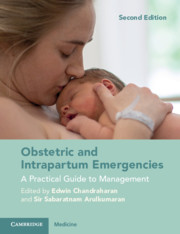Book contents
- Obstetric and Intrapartum Emergencies
- Obstetric and Intrapartum Emergencies
- Copyright page
- Contents
- Contributors
- Preface
- Preface to the First Edition
- Acknowledgements
- Section 1 General Principles
- Section 2 Algorithms for Management of the Top Five ‘Direct Killers’
- Section 3 Intrapartum Emergencies
- Chapter 8 Uterine Rupture
- Chapter 9 Breech Delivery
- Chapter 10 Umbilical Cord Prolapse
- Chapter 11 Fetal Compromise
- Chapter 12 Shoulder Dystocia
- Chapter 13 Twin Delivery
- Chapter 14 Instrumental Vaginal Delivery
- Chapter 15 ‘Crash’ Caesarean Section
- Chapter 16 Unintended Trauma and Complications During Caesarean Section
- Chapter 17 Obstetric Emergencies in Midwife-Led Settings
- Section 4 Postpartum Emergencies
- Section 5 Medical and Surgical Emergencies During Pregnancy
- Section 6 Anaesthetic Emergencies During Pregnancy
- Section 7 Neonatal Emergencies and the Management of Immediate Neonatal Problems
- Section 8 Management of Anticipated and Non-anticipated Emergencies in Pregnancy
- Section 9 Setting-Up Skills and Drills Training in Maternity Services and Reducing Avoidable Harm
- Index
- References
Chapter 14 - Instrumental Vaginal Delivery
from Section 3 - Intrapartum Emergencies
Published online by Cambridge University Press: 06 May 2021
- Obstetric and Intrapartum Emergencies
- Obstetric and Intrapartum Emergencies
- Copyright page
- Contents
- Contributors
- Preface
- Preface to the First Edition
- Acknowledgements
- Section 1 General Principles
- Section 2 Algorithms for Management of the Top Five ‘Direct Killers’
- Section 3 Intrapartum Emergencies
- Chapter 8 Uterine Rupture
- Chapter 9 Breech Delivery
- Chapter 10 Umbilical Cord Prolapse
- Chapter 11 Fetal Compromise
- Chapter 12 Shoulder Dystocia
- Chapter 13 Twin Delivery
- Chapter 14 Instrumental Vaginal Delivery
- Chapter 15 ‘Crash’ Caesarean Section
- Chapter 16 Unintended Trauma and Complications During Caesarean Section
- Chapter 17 Obstetric Emergencies in Midwife-Led Settings
- Section 4 Postpartum Emergencies
- Section 5 Medical and Surgical Emergencies During Pregnancy
- Section 6 Anaesthetic Emergencies During Pregnancy
- Section 7 Neonatal Emergencies and the Management of Immediate Neonatal Problems
- Section 8 Management of Anticipated and Non-anticipated Emergencies in Pregnancy
- Section 9 Setting-Up Skills and Drills Training in Maternity Services and Reducing Avoidable Harm
- Index
- References
Summary
Caesarean section rates are on the rise and this may be partly due to lack of appropriate training and experience in instrumental deliveries as well as medico-legal issues. Since caesarean section performed in the second stage of labour is associated with increased maternal morbidity, an appropriately performed instrumental vaginal delivery may help avoid the unnecessary risks.
Instrumental vaginal deliveries can be hazardous in inexperienced hands and should be undertaken with due care and supervision. Various intrapartum measures may help reduce the need for assisted vaginal delivery such as use of partogram, upright or lateral maternal position, one-to-one support to the woman in labour, delayed pushing in women having epidural anaesthesia or judicious use of oxytocin in the second stage of labour, especially in women with epidural anaesthesia.
- Type
- Chapter
- Information
- Obstetric and Intrapartum EmergenciesA Practical Guide to Management, pp. 98 - 106Publisher: Cambridge University PressPrint publication year: 2021



